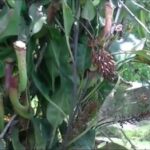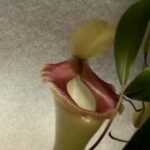As an Amazon Associate, this site earns commissions from qualifying purchases. For more details, click here.
Nepenthes maxima is one of the easier pitcher plants to grow and maintain. This plant is suitable for beginners because it does not require a lot of attention. If you are new to carnivorous plants and want something simple to start with, n. maxima is as good a plant to go with as any.
Nepenthes maxima can be cultivated on a windowsill or terrarium in partial, indirect light. Low to medium humidity is ideal with temperature at 65-80 degrees F. The soil must always be moist, but do not sit the plant in water.
Nepenthes Maxima Care
| Soil | 2 parts long fiber sphagnum (LFS), 1 part perlite and 1 part orchid bark keep soil lightly damp |
| Water | Rainwater, purified or distilled |
| Light | Bright, indirect light, sunlight or grow light are effective |
| Food | Bugs, insects, fish pellets, mealworms |
| Temperature | 65-80 F (18-26 C) |
| Humidity | 50-80% |
| Dormancy | Not needed |
| Propagation | Leaf cuttings, root cuttings |
Soil
Nepenthes maxima prefers in low nutrient media. Use 2 parts long fiber sphagnum (LFS), with 1 part perlite and 1 part orchid bark. Some growers prefer a 3:1 ratio so adjust the mix according to your preference.
Equal parts LFS and orchid bark – minus perlite – is going to work too. Or you can replace orchid bark with perlite or silica sand if it is not available. Use the suggested potting mix that came with your plant if you are not sure which to try.
These plants are often sold potted so you do not have to fret about getting the mix right. But it is easy enough to try other potting media. You can buy various types of soil but make sure that it is for carnivorous plants. Or if you prefer a simpler approach, just use Organic Earth Soil and your nepenthes is ready to go.
Never use rich soil on n. maxima. Carnivorous plants should never be grown in fertilized media. Nepenthes get their nutrients from insects so planting it in fertilized grounds could be fatal.
Once your n. maxima is planted, always keep the soil moist but not too damp. A moisture meter device like the Sonkir Soil PH Meter can be very helpful in this instance. Too much water is bad for the roots and make the plant susceptible to infection.
Pot Container
An average sized nepenthe maxima grows nicely in a 4 inch pot. Larger variants will need a 5 inch or larger container. These plants will also grow in a terrarium under the right conditions.
If you have cultivated other pitcher plants like nepenthes rafflesiana, you probably know that the 3-4 inch pot size is standard for most pitcher plants. Nepenthes maxima is not likely to outgrow this pot and you should be repotting every spring anyway, or at least every two years.
The best way to grow a potted n. maxima is on a sunny windowsill. Under the right conditions your nepenthes will thrive even with little maintenance.
Nepenthes maxima adapts well to terrariums too. However there needs to be sufficient ventilation, moisture, light, water and nutrients. If your n. maxima is a large variant, the terrarium size is going to be a factor.
Water
Nepenthes maxima does not need a lot of water, just enough to maintain the soil moisture. Rainwater is the best as well as purified, spring and RO. Tap water contains too many minerals that are potentially harmful.
N. maxima and its hybrids should be watered from the top. Use a spray bottle and water all around the plant. Repeat when the soil shows signs of drying. You can mist the plant if it is really hot.
Knowing how to water to pitcher plants is critical for their survival. While nepenthes maxima soil must be moist, too much water can seep into the roots and cause damage.
This is why you should never use the tray method. Some tropical pitcher plants handle bottom watering well but n. maxima is not one of those.
If it is really hot and the soil dries quickly, move the plant to a cooler, more humid location. A terrarium is a good idea because you can control the variables.
The bottom line is nepenthes maxima needs water, but not as much as other species. If you can keep the plant in an ideal environment, its water requirements will be reduced. As long as the soil is moist not soggy, your plant will be fine.
Light
For best results, nepenthes maxima should be in bright, indirect light. You can keep the plant on a south facing window or place it in a terrarium with artificial lights. Do not expose this plant to direct light, natural or artificial.
There are two mistakes beginners make with pitcher plants, too little or too much light. Too little light and nepenthes will not grow. Too much light and it leads to scorched leaves and dry, empty pitchers.
If your n. maxima grows in the right temperature range, that should not be an issue. But if it is too low or too high, there could be problems.
The simplest way to avoid sunburn is to position it in partial light. Set the plant on a windowsill, preferably facing south. The window will provide the light needed for photosynthesis and other functions. At the same time the window provides protection from heat.
You can do the same with artificial lights. Get an indoor plant light and position it about 15 inches above the plant. Set up the light so it is not shining directly on your nepenthes maxima. Keep the light 8-12 hours a day, following the natural light pattern in your area. You could for instance, use the Yadoker Grow Light and get great results
Temperature
The optimum temperature for nepenthes maxima is 65-80 F (18-26 C). Nepenthes prefers warm, humid days and cool evenings. You can cultivate this plant and its hybrids in terrariums and greenhouses if the temperature is suitable.
Nepenthes maxima is not capable of surviving winter freezes and should be kept in the same environment the whole time. If the climate in your area is close to 650-80 F, you can grow n. maxima outdoors. You only need to bring the plant indoors during winter.
If it gets too hot or too cold nepenthes should be cultivated indoors, a terrarium or greenhouse. Even if the weather is agreeable, keep an eye on the temperature during summer. Intense heat can burn leaves and cause liquids in pitchers to evaporate.
Humidity
Low to medium humidity is sufficient for nepenthes maxima. A humidity level of 50% is enough to keep the plant alive. These pitcher plants also tolerate higher humidity levels.
If you want the best possible setting, keep humidity at 50-80% all times. But even in less than ideal conditions nepenthes maxima should be fine. As long as the other variables like temperature, light, water, soil and nutrition are sufficient, your plant will be fine.
While humidity is vital, any shortcomings in your setup will be offset by the others. If the temperature is below 80 F and the plant is indirect light, less than perfect humidity levels will not be a problem.
Nutrition and Feeding
There is a lot of debate on whether you should feed pitcher plants or not. The bottom line is for n. maxima and its variants, it comes down to whether the plant gets nutrients on its own. If it can, then no need to feed. If the plant cannot, you have to give it food.
Pitcher plants get nutrients from small insects, in particular nitrogen. If your n. maxima is outdoors there are scores of bugs at its disposal. No feeding on your part required.
If your nepenthes is in a terrarium or otherwise unable to catch bugs, you have to drop a few bits of food – dead insects, worms, fish food – in its pitchers.
Dormancy
Nepenthes maxima is not a frost hardy plant. It does not go dormant in winter and has no protection from freeze. You have to keep this plant above freezing at all times.
You can still grow nepenthes maxima outdoors during spring and summer. Just make sure to bring it in before the temperature drops below freezing. During winter, development may slow and the plant not eat as much. However it will still be active and grow faster as spring approaches.
As stated earlier, early spring is the right time to repot, just like n. bicalcarata. This is also the best time to propagate through leaf cuttings. As nepenthes maxima resumes its normal growth and the sun starts shining, you may bring the plant outdoors again.

My fascination with carnivorous plants began many, many years ago with Venus Fly Traps. Now I am more than happy to impart what I know with other enthusiasts and those who are curious about meat eating plants.



